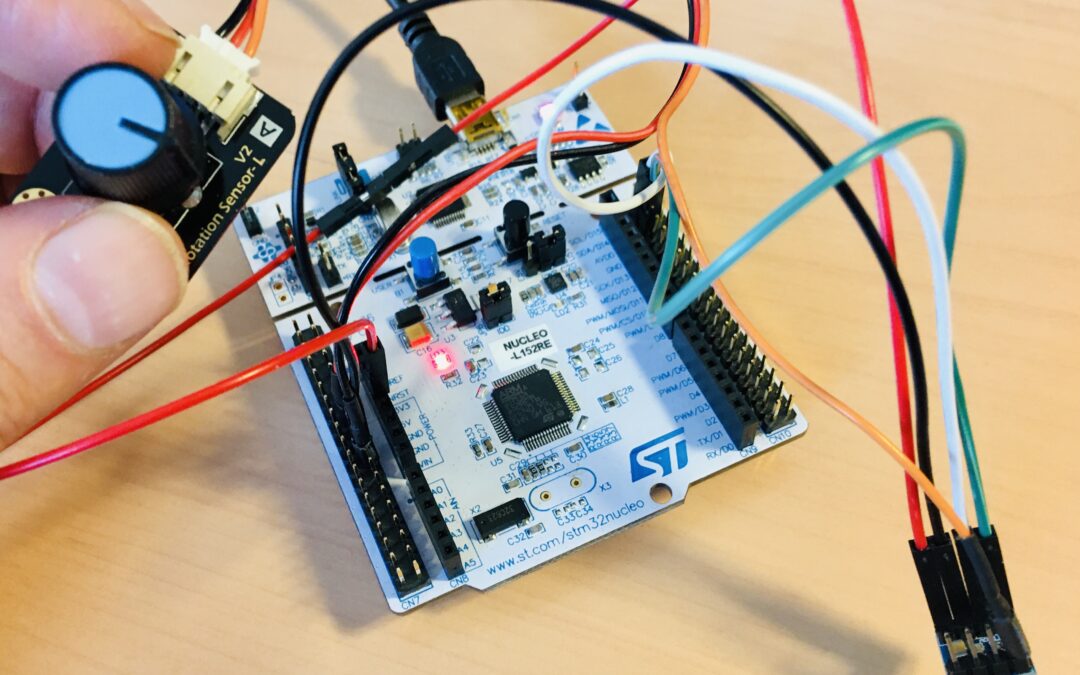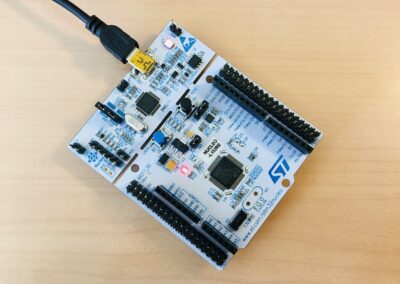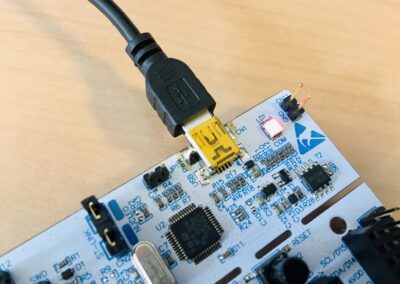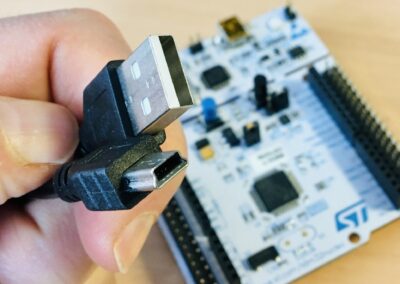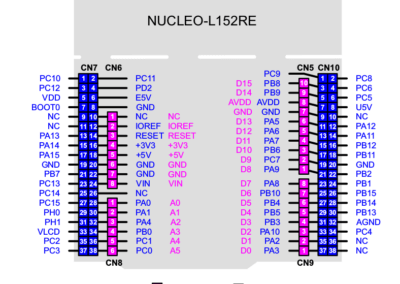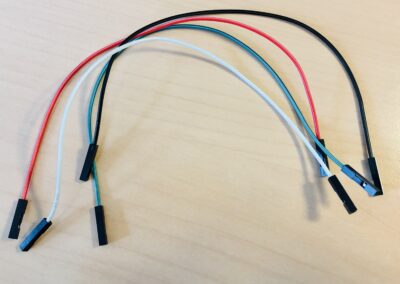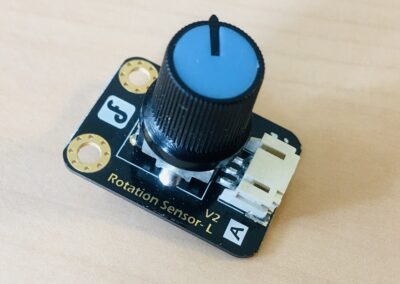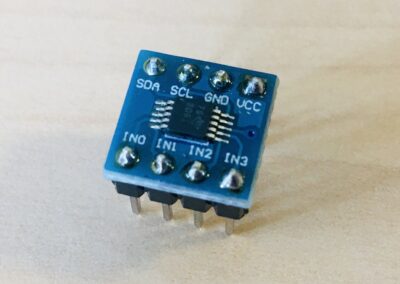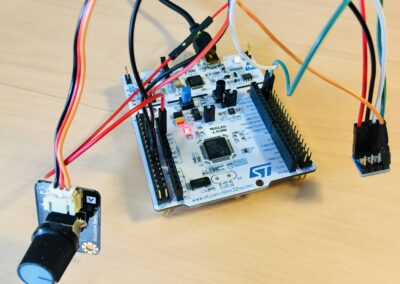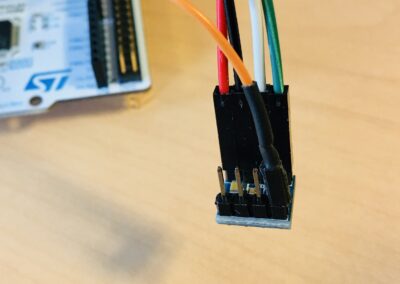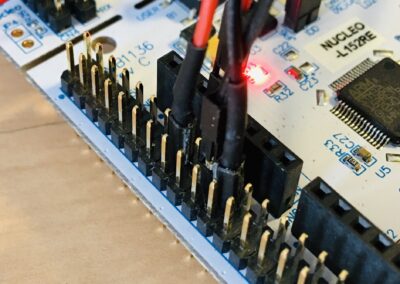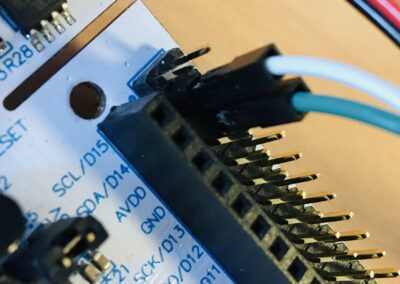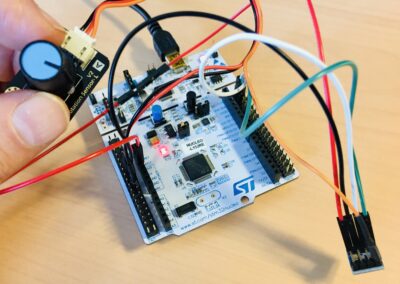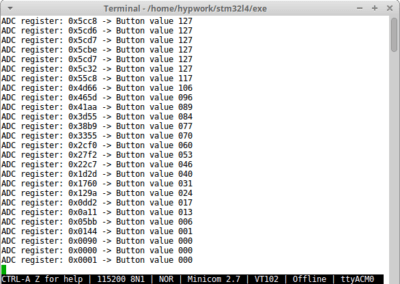This tutorial shows how to use an analog rotary potentiometer thru an Analog to Digital Converter (ADC), used as I2C device on the MB1136 evaluation kit.
- A STMicroelectronics evaluation board with STM32L152RU Cortex-M3 MCU, order code NUCLEO-L152RE (name on PCB: MB1136).
- USB 2.0 male to micro USB cable (supplied with evaluation kit).
- A full installation of an Hyperpanel OS release on a linux based PC including tools for flashing and debugging. This tutorial requires release V30.03.01 for MB1225 or higher. Hyperpanel OS releases are available for free in the “Download” section of the website.
- A Lunix PC with ARM gcc compiler, ARM gdb debugger and minicom installed.
- A text editor to edit or modify source codes (We are using vi in our demo).
- A ADS1115 Module 4 channels 16 bits I2C ADC (available on Amazon).
- An analog potentiometer. You can for exemple use the Gravity Analog Rotation Potentiometer Sensor for Arduino.
Hyperpanel OS V30.03.01 for MB1136 (hypv300301.zip) or higher, available in the Download section.
Binary file
– On www.tutorial.hyperpanel.com, select Download from the main menu.
– Download “Hyperpanel OS V30.03.01 for MB1136” or higher release for the MB1136 kit (hypv300301.zip).
– On yo ur PC Linux, copy and unzip the zip file in your root directory, for example:
cp hypv300301.zip /home/hyperpanel cd /home/hyperpanel unzip hypv300301.zip
– With a text editor, update hhome environment variable in the stm32m3 file:
cd /home/hyperpanel/hypv300301/shells vi stm32m3
Update the first line, according to your root directory:
export hhome=/home/hyperpanel/hypv300301
– Save this file and an execute the command:
source stm32m3
– From this tutorial, use the button “Binary file” to download the zip file containing the binary. Unzip this file:
unzip hpos-tuto512-bin.zip
– Copy this binary file in HyperPanelOS release:
cp potentiometer.bin ~/hypv300301/boards/stm32m3/exe
– Connect the analog rotary sensor data signal (orange wire) to pin 0 of the ADC (see image. Connect the analog rotary sensor power and ground(red and black wires) to the MB1136. Connect the ADC (power and data signals to the MB1136).
POTENTIOMETER ADC MB1136 SIGNAL WIRE
Signal <------------> in0 ADC_IN Orange
Power <-----------------------> CN8/+3V3 Power Red
Ground <----------------------> CN7/GND Ground Black
SCL <---> CN10/PB8 I2C_SCL Yellow
SDA <---> CN10/PB9 I2C_SDA Green
VCC <---> CN7/+3V3 Power Red
GND <---> CN7/GND Ground Black
– Connect the MB1136 board to a USB port on your Linux PC using the USB cable supplied with the board. Wait for a window to appear, then close it.
– Open a Terminal window and run minicom to get access to the Hyperpanel OS serial port and to the application messages:
minicom -D /dev/ttyACM0 -b 115200
– Open another Terminal window on your computer and enter the following commands:
cd ~/hypv300301/shells source stm32m3 exe
– Upload software to the board:
hgdb romload stm32m3 potentiometer
You should see messages similar to these:
Open On-Chip Debugger 0.10.0+dev-00001-g0ecee83-dirty (2017-02-10-06:53)
Licensed under GNU GPL v2
For bug reports, read
http://openocd.org/doc/doxygen/bugs.html
0x00002eca in ?? ()
target halted due to debug-request, current mode: Thread
xPSR: 0x01000000 pc: 0x00003140 msp: 0x20002000
auto erase enabled
target halted due to breakpoint, current mode: Thread
xPSR: 0x61000000 pc: 0x20000046 msp: 0x20002000
wrote 393216 bytes from file potentiometer.bin in 11.261815s (34.098 KiB/s)
potentiometer.elf: No such file or directory.
Wait until the flashing operation is complete (approx. 30 seconds). The last message (potentiometer.elf: No such file or directory) is normal.
– You can now press on the reset button (black button) of the MB1136. Hyperpanel OS and the application will start. You can turn the analog rotation sensor. The digital converter value, from 0 to 127 appears on the serial port.
To go further
If you want to edit the source code, write modifications, compile, link, etc., here’s how to do it :
- From this tutorial, use the button “Source code” to download the zip file containing the source file. Unzip this file:
unzip hpos-tuto512-source.zip
- Copy this source code in HyperPanelOS release:
cp potentiometer.c ~/hypv300301/user/stm32app
- Copy the link file in Hyperpanel release:
cp potentiometer.lst ~/hypv300301/boards/stm32m3/exe
- You can edit and make any modifications you want in the source file. For example, you can modify the calibration of the [0,…,127] values by changing the max value at the line 189 of the source file.
cd ~/hypv300301/user/stm32app vi potentiometer.c
- Save the source file.
- Compile the source file:
cd ~/hypv300301/user/stm32app cmm potentiometer
- Call the linker to create the new binary file:
exe lhypos potentiometer
- You can now upload this new binary to the board, in the same way as in the previous Installation chapter.
Potentiometer :
- The potentiometer send continuous voltage tension from [0v,…,3.3V]. This tension is converted by the ADC to a 16-bit value. The app is just a main loop who read this 16-bit value (I2C register) each 100 ms.
- At the position corresponding to minimum value, the potentiometer deliver 0V. At the maximum value, the potentiometer delivers 3.3V so we have to calibrate the ADC settings to this range.
Analog to Digital Converter (ADC) :
- The ADC use the potentiometer as analog input signal et send digital output data to the MB997D via I2C interface.
- The ADC converter include one single I2C device. There is 4 analog input channels. In this app we use Input 0 (data signal). This configuration is setted with bit 14-12 of the configuration register.
- We select FS=+/-4.096V for the PGA (Programmable gain amplifier) of the ADC (cf. datasheet of the ADC) to fit with range (0-3.3V] of the potentiometer.
2C Interface :
- I2C address are 0x90 (write) and 0x9 (read).
- The ADS1115 have a configuration register. The app write de configuration in the initialisation step, and read the configuration register to check that the write operation is ok. Configuration register is set as follow (see datasheet page 18/19/20).
bit 15 Operational status 0 (default)
bit 14-12 Multiplexer config - INp=0 INn=GND 100 (INp=0 Nn=GND)
bit 11-9 Gain amplifier FS= +/- 6.144V 001 (+/-4.06V)
bit 8 Device operating mode 0 (continuous)
bit 7-5 Data rate 111 (860SPS)
bit 4 Comparator mode - Traditional 0 (default)
bit 3 Comparator polarity - Active low 0 (default)
bit 2 Nn-latching comparator 0 (default)
bit 1-0 Disable comparator 11 (default)
0100001011100011 = 0x42E3Documents
Links
Potentiometer is running
hypos-tuto512-source
/*
** potentiometer.c - Sample code for HyperpanelOS ======================== **
** **
** This simple code is located into the application container, it is run **
** by the VMK sub-operating system. On the other hand, the I/O container **
** runs all the drivers that are VMIO finite state machines. **
** **
** The goal of this small app is to use a analog potentiometer. **
** **
** ======================================================================= **
*/
/* Documentation for I2C devices --------------------------------------------
Product used :
- Ben-Gi Mini ADS115 Module 4 channels 16 bits I2C ADC
www.amazon.fr/gp/product/B07PK1Z5H1
datasheet-ads115.pdf - Texas Instruments
16-bit Ananlog-to-Figital Converter
- Rotation Sensor-L V2 from LattePanda Starter Sensor Set
www.lattepanda.com
wiki.dfrobot.com/Analog_Rotation_Sensor_V2__SKU__DFR0058_#target_4
Potentiometer:
- The potentiometer send continuous voltage tension from [0v,3.3V] this
tension is converted by the ADC to a 16-bit value. The app is just a
main loop who read this 16-bit value (I2C register) each 100 ms.
- At the position corresponding to minimum value, the potentiometer deliver
0 V. At the maximum value, the potentiometer delivers 3.3V so we have
to adapt the ADC settings to this range.
Analog to Digital Converter (ADC):
- The ADC use the potentiometer as analog input signal et send digital
output data to the Pyboard via I2C interface.
- The ADC converter include one single I2C device. There is 4 analog
input channels. In this app we use Input 0 (data signal). This
configuration is setted with bit 14-12 of the configuration register.
- We select FS=+/-4.096V for the PGA (Programmable gain amplifier) of the
ADC (cf. datasheet of the ADC) to fit with range (0-3.3V] of the
potentiometer.
I2C Interface:
- I2C address are 0x90 (write) and 0x9 (read).
- The ADS1115 have a configuration register. The app write de configuration
in the initialisation step, and read the configuration register to check
that the write operation is ok. Configuration register is set as follow
(cf. datasheet page 18/19/20).
bit 15 Operational status 0 (default)
bit 14-12 Multiplexer config - INp=0 INn=GND 100 (INp=0 Nn=GND)
bit 11-9 Gain amplifier FS= +/- 6.144V 001 (+/-4.06V)
bit 8 Device operating mode 0 (continuous)
bit 7-5 Data rate 111 (860SPS)
bit 4 Comparator mode - Traditional 0 (default)
bit 3 Comparator polarity - Active low 0 (default)
bit 2 Nn-latching comparator 0 (default)
bit 1-0 Disable comparator 11 (default)
0100001011100011 = 0x42E3
*/
/* Include files and external reference -------------------------------------*/
#include <hypos.h> // Hyperpanel OS basic interfaces.
#include <drv_asy.h> // Prototype of "asy_write()".
#include <drv_i2c.h> // Prototype of "i2c_*()".
/* Internal defines of this module ------------------------------------------*/
#define TICK 1000 // Code for tick event.
#define ADC_AD_W 0x90 // I2C dev address - ADC (write)
#define ADC_AD_R 0x91 // I2C dev address - ADC (read)
#define CONVERSION_REG 0x00 // I2C register - Converted value
#define CONFIG_REG 0x01 // I2C register - Configuration
#define INIT 0 // I2C command - ADC initialisation
/* Internal global variables of this module --------------------------------*/
static unsigned int idto ; // Timer identifier.
/* INIT command .............................................................*/
static const char init[] = // I2C command - ADC initialisation
{
/* Length-1, Address, Control byte, Data byte */
3, ADC_AD_W , CONFIG_REG , // Write the configuration register
0x42, 0xE3 , // Cf. datasheet page 19)
0 , // End of command set
} ; //
static char *command[] = // I2C commands table
{ //
(char*)&init , // I2C command - INIT
(char*)0 // End of list
} ; //
/* Prototypes --------------------------------------------------------------*/
static int loop_app_task(void*) ; // Prototype
static int wait_evt(void) ; // Prototype
static void set_command(int) ; // Prototype
/* Beginning of the code ---------------------------------------------------
loop_app_tsk Application entry point
*/
/* Procedure loop_app_tsk --------------------------------------------------
Purpose : This is our task main loop.
*/
int loop_app_tsk (void *param)
{
int ev = TICK ; // Our event
char mess[16] ; // Message to be sent on ASY0
unsigned char frame[16] ; // I2C read frame
int ret = 0 ; // Return procedure code
/* Step 1 - Start a timer that will send an event every second ..............*/
set_uto(CLOCK , // Timer mode: clock
100 , // Duration in milliseconds
TICK , 0 , // Event code and reserve field
&idto ); // Timer identifier
/* Step 2 - ADC initialisation ..............................................*/
asy_write(0,(unsigned char*)"Init ... ",9);
set_command(INIT) ; // ADC initialization
asy_write(0,(unsigned char*)"donern",6);
ret = i2c_read( // Just for checking, read the register
0 , // I2C controller number
0 , // I2C protocol code
ADC_AD_R , // Target I2C read address
CONFIG_REG , // Sub-address value
frame , // Receive data buffer address
2 , // Count of bytes to be read
0 ); // List of option flags
hsprintf(mess,
"Configuration register 0x%02x%02x (%d)rn",
frame[0],frame[1],ret);
asy_write(0 , // Write on ASY0 the value of the
(unsigned char*)mess , // configuration register.
strlen(mess) ); // Count of bytes to be sent
/* Step 3 - Main loop .......................................................*/
wait_ev : // Beginning of loop label
if ( ev == TICK ) // If the event is the tick event
{ //
frame[0]=0 ; // Reset frame.
frame[1]=0 ; // Reset frame.
ret = i2c_read( // Read current value get from the ADC
0 , // I2C controller number
0 , // I2C controller code
ADC_AD_R , // Target I2C read address
CONVERSION_REG , // Sub-address value
frame , // Receive data buffer address
2 , // Count of bytes to be read
0 ); // List of option flags
frame[0]= frame[0] EQ 0xFF ? 0x00 : frame[0];
hsprintf(mess , // Message with the 16-bit value.
"ADC register: 0x%02x%02x -> Button value %03drn",
frame[0],frame[1] , // Conversion Voltage -> [0,127]
(frame[0]*0x7f)/0x5c,ret); // (0x5c max value read from
// register with this model of
// potentiometer).
asy_write(0 , // Write on ASY0
(unsigned char*)mess , // the "mess" message
strlen(mess) ); // Count of bytes to be sent
}
ev = wait_evt() ; // Unschedule until an event is received
goto wait_ev ; // Wait for the next event
return 0 ; // Return code of the procedure
}
/* Procedure wait_evt ------------------------------------------------------*/
/*
Purpose : Unschedule until the next event is received, whatever it is.
*/
static int wait_evt (void)
{
unsigned int waitlist[1][3] ; // Parameter of "waitevt_task"
/*****************************************************************************
* Step 1 : Build a list with one WAIT_CODEINT entry that will accept all *
* ------ the event codes ranging from 0 to 20000. Then call *
* "waitevt_task", we will be unscheduled until the next event will *
* be received *
*****************************************************************************/
waitlist[0][0] = WAIT_CODEINT ; // All events with
waitlist[0][1] = 0 ; // a code between 0
waitlist[0][2] = 20000 ; // and 20000
waitevt_task(waitlist , // Address of waiting list
1 , // Size of "waitlist[]"
0 , // maximum waiting time = no
0 ) ; // Do not purge previous events
/*****************************************************************************
* Step 2 : Here we are scheduled again. The VMK has written into its *
* ------ global variable "task_evt" a copy of the event that has *
* scheduled us again. *
*****************************************************************************/
return task_evt.code ; // Return event code
}
/* Procedure set_command ---------------------------------------------------*/
/*
Purpose : Send a set of commands to I2C devices.
*/
static void set_command(int cmd)
{
i2c_write( // Send I2C command
0 , // Controller number
PRO_I2C_DEV , // Protocol code
-1 , // Target address unused with FLG_MULTI
0 , // Target sub-address
(unsigned char*)command[cmd] , // Command
sizeof(command[cmd]) , // Count of bytes unused with FLG_MULTI
FLG_MULTI ); // Several commands in I2C buffer
}
Terminal
~/hypv300301/boards/stm32m3/exe >> hgdb
GNU gdb (7.10-1ubuntu3+9) 7.10
Copyright (C) 2015 Free Software Foundation, Inc.
License GPLv3+: GNU GPL version 3 or later <http://gnu.org/licenses/gpl.html>
This is free software: you are free to change and redistribute it.
There is NO WARRANTY, to the extent permitted by law. Type "show copying"
and "show warranty" for details.
This GDB was configured as "--host=x86_64-linux-gnu --target=arm-none-eabi".
Type "show configuration" for configuration details.
For bug reporting instructions, please see:
<http://www.gnu.org/software/gdb/bugs/>.
Find the GDB manual and other documentation resources online at:
<http://www.gnu.org/software/gdb/documentation/>.
For help, type "help".
Type "apropos word" to search for commands related to "word".
man Display again this manual
stm32m3 Send the reset halt command to openocd
armdisconnect Deconnexion command
peek adr Read and display a 32 bit value at adr
poke adr val Write a val 32 bits value at adr
poke_m adr msk val Write bits in a 32 bits word with a mask
peekrange base o1 o2 Read 32 bits words from base+o1 to base+o2
affichb adr size Print a memory area starting at adr
vmio n Display the tnote_evt_s debug table
int Display the tnote_it debug table
rte Return from interrupt
romload stm32m4 app Write the app executable file in flash
rom stm32m3 app Connect to target and load app dbg symbols
gpio bank n state Set GPIO n (0-15) of bank (1-9) to 0/1
clock 0/1/2/3 Output SYSCLK/PLLI2S/HSE/PLL to MO2/PC9
(gdb) romload stm32m3 potentiometer
Open On-Chip Debugger 0.10.0+dev-00001-g0ecee83-dirty (2017-02-10-06:53)
Licensed under GNU GPL v2
For bug reports, read
http://openocd.org/doc/doxygen/bugs.html
0x00012a3a in ?? ()
target halted due to debug-request, current mode: Thread
xPSR: 0x01000000 pc: 0x00003140 msp: 0x10002000
auto erase enabled
target halted due to breakpoint, current mode: Thread
xPSR: 0x61000000 pc: 0x20000046 msp: 0x10002000
wrote 393216 bytes from file potentiometer.bin in 11.165994s (34.390 KiB/s)
Cannot access memory at address 0x8000f8d0
(gdb)

